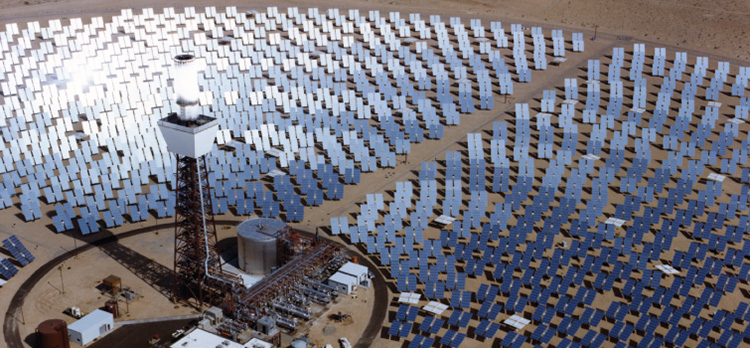Engineers Receive SunShot Grant to Develop Less Costly, More Efficient Solar Collectors
Published Date
By:
- Liezel Labios
Share This:
Article Content

The Energy Department’s SunShot Initiative funds projects aimed at developing lower cost, higher efficiency solar collectors. Courtesy of U.S. Department of Energy.
University of California San Diego electrical and computer engineering professor Boubacar Kante will lead a three-year, $2.5 million project funded by the U.S. Department of Energy SunShot Initiative aimed at making solar energy systems cost-competitive with traditional energy sources. With this funding, the researchers plan to develop a new class of solar collectors – based on dielectric metasurfaces – that focus sun rays spanning a wider angular range and allow scaled-down, less expensive tracking systems.
The innovative project will be performed in collaboration with Sandia National Laboratories and will drive innovation to make solar energy systems cost-competitive with traditional energy sources.
“UC San Diego is known as the pioneer of metamaterials research and development. We are at the forefront of efforts to develop structured matter that can be used to control light at will. I am confident that, in collaboration with Sandia, we can leverage our advances in metamaterials research in order to develop less expensive and more efficient solar concentrator systems,” said Kante.
Solar collectors are optical systems that collect and concentrate sunlight onto a small area receiver. The concentrated light heats a thermal fluid, which creates steam to generate clean electricity. Today’s state-of-the-art solar collectors typically use curve-shaped (parabolic) systems to concentrate sunlight. But their curvature limits the range of angles of incoming sunlight that the solar collectors can capture. As a result, these systems must continually track the sun’s motion throughout the day. Funding for the new project will be used to design, develop and fabricate a new class of planar solar collectors that can operate over a broad spectrum of sunlight, thereby reducing the need for expensive continuous tracking systems.
“Critical success factors lie in the ability of this new technology to make use of most of the entire solar spectrum as well as its capacity for large-scale fabrication and integration. In this collaboration, we will address both these issues,” said Julius Yellowhair, a researcher from Sandia National Laboratories who will co-lead the project with Kante.
The goal of the proposed technology is to reach a cost to collection efficiency ratio ($/m2) of less than 0.91, which would be disruptive to current technologies as defined by the SunShot Initiative. Achieving a wider acceptance angle will relax some of the requirements placed on tracking systems and has the potential to significantly reduce the cost, researchers said.
Kante’s team has already made many contributions to the field of metamaterials, which involves developing materials that have properties that do not exist in nature. The researchers will leverage their recent findings on specially designed surfaces that can encode curvature into the phase of planar structured matter.
Sandia National Laboratories operates the National Solar Thermal Test Facility (NSTTF), the only facility of its kind in the United States with test capabilities for concentrating solar power (CSP) technologies. Sandia will perform on-sun testing of the prototype solar collectors. Sandia also has nano-fabrication capabilities, which it will use to fabricate and assemble meter-scale metasurface solar collectors.
If successful, the UC San Diego-Sandia solar collector design could provide solar thermal plants with a low-cost collector that is more efficient than current collectors.
“We are excited to tackle this challenge as the time has now come to use metamaterials for real world applications.” Kante said.
More information about the SunShot awards can be found here.
Share This:
You May Also Like
Stay in the Know
Keep up with all the latest from UC San Diego. Subscribe to the newsletter today.



